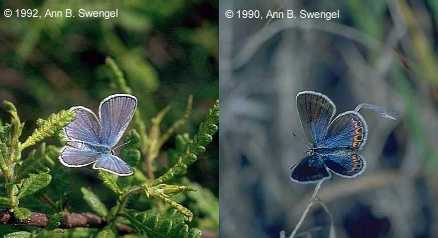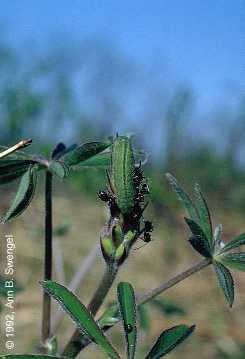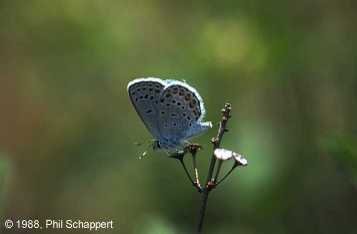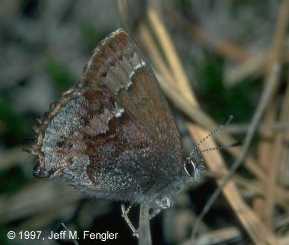 Articles...
Articles... 
The Extirpation of the Karner Blue
from Ontario, Canada
© 2000, Phil Schappert
 The Karner Blue butterfly, Plebejus (Lycaeides) melissa samuelis (Lycaenidae), seen at left here (male, far left, female; near left), is rare in all but a few remnant populations throughout its northeastern North America range. It is federally endangered in the northeastern United States (Indiana, Michigan, Minnesota, New Hampshire, New York, Ohio and Wisconsin) and is considered extirpated or locally extinct from Ontario, the only region where it occurred in Canada. The extirpation of the Karner blue in Ontario provides some useful lessons in butterfly conservation planning.
The Karner Blue butterfly, Plebejus (Lycaeides) melissa samuelis (Lycaenidae), seen at left here (male, far left, female; near left), is rare in all but a few remnant populations throughout its northeastern North America range. It is federally endangered in the northeastern United States (Indiana, Michigan, Minnesota, New Hampshire, New York, Ohio and Wisconsin) and is considered extirpated or locally extinct from Ontario, the only region where it occurred in Canada. The extirpation of the Karner blue in Ontario provides some useful lessons in butterfly conservation planning.
The Karner Blue is an example of a "classic" rare species—that is, one in which individuals have small restricted distributions or geographic range and narrow habitat specificity—of the northeastern United States and southeastern Canada. In Ontario, it was known to exist at six sites around the turn of the last century, but only two of these locations persisted into the 1980's. The habitat of the Karner Blue in Ontario is characterized as Black Oak Savannah—short grass prairie with interspersed copses of oaks and pines—and is itself considered threatened, currently occupying less than 0.02% of its former range in Canada.
 The Karner Blue uses lupine, Lupinus perennis (Fabaceae or Leguminosae), as its obligate hostplant, associates with ants that defend the larvae from predators, and requires the availability of ample nectar resources as adults. While the caterpillars are often tended by ants, as shown at right, they do not absolutely require their protection since they feed on chemically defended lupines that contain noxious alkaloids. Nevertheless, their survival is better when ants are present than it is when they are absent.
The Karner Blue uses lupine, Lupinus perennis (Fabaceae or Leguminosae), as its obligate hostplant, associates with ants that defend the larvae from predators, and requires the availability of ample nectar resources as adults. While the caterpillars are often tended by ants, as shown at right, they do not absolutely require their protection since they feed on chemically defended lupines that contain noxious alkaloids. Nevertheless, their survival is better when ants are present than it is when they are absent.
They have two broods per year with the progeny of the second brood overwintering and producing a spring first brood that produces, without diapause, a second summer brood. The Karner Blue exhibits a metapopulation structure and population studies were conducted at both remaining sites in Ontario in 1984 and then again in 1986. At the more populated site there were estimated to be 100 first brood adults and 850 second brood adults in 1984 and 300 first brood and 920 second brood adults in 1986. The low population sizes of the first brood are thought to be due to overwintering losses.
 Three years later only 1 adult was seen during the flight period of the second brood; and none were encountered in 1990. The photo at left is of a lone male Karner Blue perches waiting for a female that never arrives. I took this photo on July 9, 1988, the day that the Karner Blue Sanctuary at Port Franks, Ontario, Canada, opened. This male was the first Karner Blue I had ever seen but, unfortunately, it also is one of the last Karner Blues ever seen in Ontario: they were declared extirpated, or locally extinct, in 1989. The population had gone from moderate to high population levels to zero in only 3 or 4 years! Why such a drastic decline?
Three years later only 1 adult was seen during the flight period of the second brood; and none were encountered in 1990. The photo at left is of a lone male Karner Blue perches waiting for a female that never arrives. I took this photo on July 9, 1988, the day that the Karner Blue Sanctuary at Port Franks, Ontario, Canada, opened. This male was the first Karner Blue I had ever seen but, unfortunately, it also is one of the last Karner Blues ever seen in Ontario: they were declared extirpated, or locally extinct, in 1989. The population had gone from moderate to high population levels to zero in only 3 or 4 years! Why such a drastic decline?
In the late 1930s and early 1940s, some errant biologists assessed the Black Oak Savannah habitat around the southeast shore of Lake Huron as "degraded pine forest" since the bulk of Ontario was, or at least had been, covered in white/red pine forests. A massive effort was begun that culminated in the planting of millions of pine trees. The decline of the Karner Blue began with this massive habitat change. The planting effort, together with the interruption of the natural fire regime that had acted to keep the savannah open, resulted in the development of a closed forest canopy that the lupines could not endure. Other habitat losses due to competition between humans and butterflies for prime lakefront properties also occurred. However, while habitat fragmentation and degradation were contributing factors that resulted in the slow decline of Karner Blue population numbers, and extinctions of local satellite populations, the factor that is most responsible for their extirpation from Ontario, was the occurrence of an extended drought in 1987-89. The drought caused the early senescence of the lupine so that the second brood caterpillars were unable to complete their development.
Restoration efforts for the habitat (opening the canopy through prescribed burning, brush and selective tree removal, planting lupines and nectar sources) have begun and efforts have been made to generate multiple satellite habitats with corridors to suit the metapopulation dynamics of the Karner Blue. Restoration efforts have, however, encountered problems: the Pinery is a provincial park that carries more than 8 times it's areal carrying capacity in white tailed deer (Odocoileus virginianus, Cervidae: Mammalia). As soon as lupines or vital adult nectar source plants begin to germinate in the areas opened by restoration work the deer eat them. It only takes a couple of years of such heavy herbivory to completely deplete the soil seed bank if left unchecked. This problem has hampered ongoing plans to reintroduce the Karner Blue to restored habitats and has been compounded by arguments over culling methods, times and participants. Another anticipated future problem will be in acquiring reintroduction stock, because the Karner Blue is federally endangered, thus protected, in the northeastern United States, the only potential source of colonists. Recent legislation also now requires that government representatives approve any reintroduction of Specially Protected Invertebrates.
 Like the Karner Blue, the Frosted Elfin, Callophrys (Incisalia) irus (Lycaenidae), is also dependent on lupine host plants. It has not been seen in Ontario since 1989 and is likely also extirpated for the same reasons that the Karner blue has disappeared. Habitat restoration for the Karner blue will undoubtedly also aid the frosted elfin.
Like the Karner Blue, the Frosted Elfin, Callophrys (Incisalia) irus (Lycaenidae), is also dependent on lupine host plants. It has not been seen in Ontario since 1989 and is likely also extirpated for the same reasons that the Karner blue has disappeared. Habitat restoration for the Karner blue will undoubtedly also aid the frosted elfin.
What lessons can be learned from the extirpation of the Karner Blue in Ontario?
First, even moderately sized populations can decline sharply in short periods of time, especially when abrogated by unusual weather conditions. However, it is important to also realize that the Karner Blue did persist for an extended period of time, at what proved to be dangerously low densities, in isolated pockets of habitat. A second lesson, therefore, is that, at some level, rare species may persist for long periods of time without our intervention. Could small-scale rehabilitation of their habitat have saved them before they were extirpated? Evidence suggests that it could have, since considerable increases in lupine growth results from simply opening the canopy. A third lesson is that we must know the ecology and biological requirements of an organism thoroughly before intervening—we need detailed information on population structure, resource requirements, life history parameters, dispersal abilities, etc. As we have learned, to the detriment of some butterfly species, beginning conservation efforts without a good understanding of the organism may do more harm than good.
Anyone who would like to learn more about The Extirpation of the Karner Blue butterfly in Ontario should see the paper with this title by Laurence Packer in the 1994 volume Karner Blue Butterfly: a symbol of a vanishing landscape, pp. 143-151, D. A. Andow, R. J. Baker, and C. P. Lane, eds., Misc. Pub. 84-1994, Minnesota Agricultural Experiment Station, University of Minnesota, St. Paul, MN.
Update (February 2000): The cull of white-tailed deer in the provincial park has finally occurred and the deer population has been reduced four-fold. Recent successful reintroductions of captive-reared stock from the Toledo Zoo, and their subsequent reproduction in at least one site, together with ongoing habitat restoration by members of the Ontario Karner Blue Recovery Team (OKBRT), provides real hope that reintroduction of the Karner Blue in Ontario is possible within the next few years. For more information about the OKBRT and its efforts to rehabilitate Black-Oak Savannah habitats and reintroduce the Karner Blue in Ontario, please contact OKBRT co-chairs Peter Carson or Dawn Burke at the Ontario Ministry of Natural Resources.


